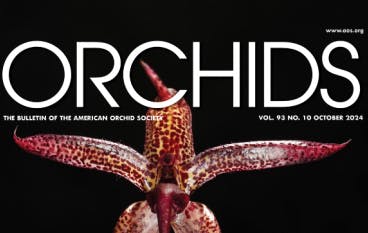
Habenarias have a lot of things in common with potatoes, although their flowers are a lot more attractive. They both go through five distinct stages during their annual development. Once you understand their life cycle, you get many insights into their cultural needs. Here is a side–by–side comparison of the life stages of growing potatoes and habenarias, and how best to grow them during each stage.
Growing and flowering habenarias is straightforward — keep them moist and in bright light while in active growth. It can get a little tricky what to do with them as they are breaking dormancy at the beginning of the growth cycle and entering dormancy at the end of their annual life.
BREAKING DORMANCY
If you store your tuberoids in clear plastic bags, you can check them weekly for signs of breaking dormancy. You will see the beginnings of green growth at the growing tip of the tuberoid in the spring. This is the time to pot up the tuberoid.
Tall Pots. Use tall pots for your habenaria tuberoids. You want the growing tip at the top of the tuberoid to be about ½ inch (1.25 cm) below the top rim of the pot. Your hope is that by the end of the growing season, the plant will produce two tuberoids for each one planted, so select a pot that can comfortably hold the tuberoids hoped for at year end. Many use plastic pots, which tend to hold more moisture; clay pots are more stable and resistant to tipping over. Whichever type you use, make sure it is tall.
Bottom of the Pot. Add an inch (2.5 cm) or so of perlite to the bottom of the pot before adding your potting mix. This gives the tuberoids an airy place to grow into. Do not use Styrofoam peanuts or other drainage material in the bottom of the pot.
Potting Mix. A peat–based soilless mix such as Pro–Mix is often recommended. This stayed too dry under my conditions. Perhaps the pot had been overfilled with Pro–Mix so it could not be watered properly, or perhaps sponge rock should not have been blended with the Pro–Mix. This year the habenarias were potted in long–fibered New Zealand sphagnum moss instead of Pro–Mix. The sphagnum was wound around the tuberoids to about ½ inch (1.25 cm) of the growing tip. Once the leaves began to emerge, a final layer of sphagnum was added up to the top of the tuberoid at the base of the new growth. The sphagnum was prewetted, but water should be added only sparingly, if at all, until the first rosette of leaves appears. The new roots grow from the top of the tuberoid at the base of the plant. There is no point in watering until there are roots that can absorb the moisture, although some suggest that a little moisture can encourage breaking dormancy, whereas too much moisture will just cause the tuberoid to rot. Once the leaves have formed, keep the plant constantly moist.
[1] Habenaria Regnieri

[2] Habenaria crinifera

[3] The new growth consumes the starches stored in the tuberoid. Once the leaves develop, the plant can start producing its energy from photosynthesis.

[4] The new roots emerge from the growing tip at the base of the new growth. There is no point in watering until the roots can absorb the moisture.

[5] Store your tuberoids over the winter in clear plastic bags so you can check for new growth in the spring.

ENTERING DORMANCY
After flowering, you will start reducing your watering frequency, letting the plants dry a bit between waterings. Eventually, the plants will start to yellow, and basically they have stopped growing, so you should stop watering them. Let the plants dry out. The leaves will brown and wither. Leave the top growth in place for another couple of weeks, until the plant can be separated from the tuberoid with a gentle tug. That is the time to unpot your tuberoids and store them for the winter.
You might read some recommendations about putting the plant and pot in a plastic bag for the winter or isolating the plants and not watering until you start seeing top growth in the spring. This approach worked for me for several years, and then around year three, there was a mass extinction event. Unpotting the tuberoids for the winter dormancy has made all the difference in successfully growing habenarias in my growing area.
Habenarias are basically annuals, unlike so many of our other orchids. Pretend you are a potato farmer and grow those tuberoids, the flowers make it all worthwhile.

Acknowledgments
Credit to the Mad, I mean Translational Scientist Brandon Silvester for my potato epiphany. He told me “Use blue light for tuber growth, it works for radishes!”
— Sue Bottom started growing orchids in Houston in the mid–1990s after her husband Terry built her first greenhouse. They settled into St. Augustine, Florida, Sue with her orchids and Terry with his camera and are active in the St. Augustine Orchid Society, maintaining the Society’s website and publishing its monthly newsletter. Sue is also a member of the AOS Editorial Board (email: sbottom15@ gmail.com).












